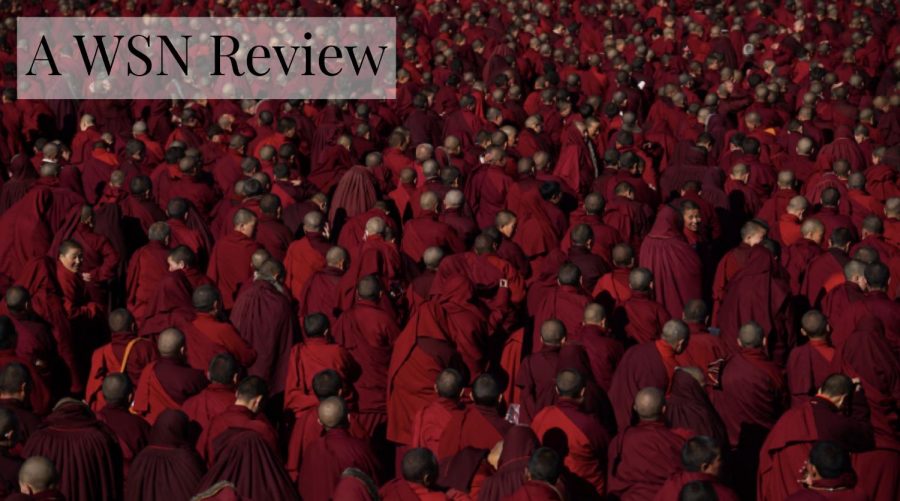‘Dark Red Forest’ points you toward nirvana
Directed by Jin Huaqing, “Dark Red Forest” is a loving ode to religious perseverance in adverse conditions. The film is currently playing as part of ND/NF 2021.
“Dark Red Forest” is a documentary directed by Jin Huaqing. This documentary captures the annual retreat of thousands of red-cloaked Tibetan nuns to the Tibetan Plateau. (Photo Courtesy of Cinetic Media)
May 4, 2021
Thousands of Tibetan nuns retreat to the Tibetan plateau each year and live in small wooden houses under extreme weather conditions. Jin Huaqing’s directorial debut “Dark Red Forest,” follows this event, registering every hour of every day in the lives of these nuns, arriving at a mesmeric, quasi-religious film-viewing experience.
“Dark Red Forest” covers a lot of ground in its 85-minute runtime. The film begins with a barren plateau full of snow that slowly but surely becomes populated by a myriad of uniform, albeit entirely distinguishable characters who all wear red religious garments. The barren land becomes covered in tiny red houses and the film’s title becomes clear.
The film moves through the seasons, resisting the urge to narrate. Jin simply lets everyday life unfold as a visual chain. The nuns pray, heal, wander, sit and sleep. Not much happens, and a great sense of languor permeates the film as it tracks the monotonous motions of everyday life. To the impatient viewer, the film might yield a simple feeling: boredom. But, to the active viewer, it conveys something much greater: a sense of transcendence.
It’s one thing to move through life, but to really sit down and watch it unfurl is something entirely different. As Jin tracks a red-cloaked nun walking about in the dead of dawn, the viewer is offered the chance to engage in a form of leisure that engenders contemplation. With nothing happening on screen, the burden to derive meaning from the images at hand falls upon the viewer.
“Dark Red Forest” is the embodiment of Blaise Pascal’s declaration that humans cannot withstand being alone in a room for too long because they’re afraid they’ll become overwhelmed by their thoughts. The film acts as an action-less respite from commercial cinema and standard documentary techniques that separates viewers from the world. It places them in a state of stillness where they can work out their philosophies by staring at the screen and searching their souls.
As it kindles contemplation, the film dares the viewer to keep watching for no reason. Nothing happens in the film, and that’s what’s so great about it. “Dark Red Forest” is unlike other films in that it’s motive doesn’t concern providing the viewer with a story to invest themselves in. Instead, it provides them with the space to contemplate images and reflexively question how they relate to these images and why they’ve decided to spend time with said images.Which, given the film’s subject matter — monastic retreat — makes perfect sense.
Instead of narrating the ins and outs of the nuns’ daily practices, Jin turns their religious lifestyle into an emotional filmic language, having viewers live out the same experience these nuns are going through. The film offers viewers the chance to engage with every image it plasters on the screen, but never forces a message down anyone’s throat. It’s the ultimate act of passiveness that instills calm with the intent of inciting nirvana.
The images are so still at times that you begin to question whether the film is buffering. During these moments, the screen acts like a canvas at a museum, projecting an immortal stillness that demands meditation. Looking at the film as a whole, it could be argued that it mimics the patterns of panelled paintings. It slowly takes you from one scene to another, with the hopes of eliciting introspection, once you’re done processing it all.
This sentiment manifests itself clearly toward the end of the film through the colorful festival that concludes the nuns’ retreat. After an hour or so of pure silence and dreary winter imagery, the explosion of colors present in the nuns’ euphoric dancing confirms the fact that something splendorous lived beyond the staleness present throughout the rest of the film.
And then, abruptly, the credits begin to roll, the experience comes to an end and you’re left to recollect. You’ve engaged with life unfurling, and now the director beckons you to engage with your own life as an artistic wonder.
Contact Nicolas Pedrero-Setzer at [email protected].
























































































































































